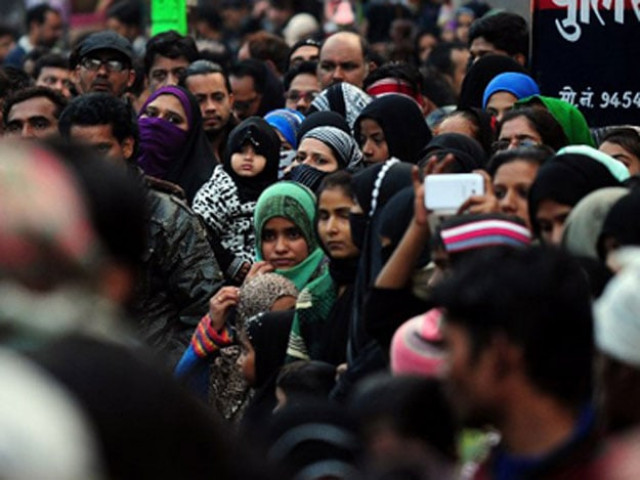Population growth and socio-economic progress
Unchecked rise in population can nullify efforts to bring millions out of poverty

Last week was spent commemorating and discussing the Population Day. A myriad of discussions ensued, denouncing the rapid population growth in the country.
Webinars, newspapers and social media platforms were flooded with expert (and not-so-expert) opinion about disadvantages of the high population growth in the country. This is being considered important since Pakistan has now become the fifth most populated country in the world.
There was discussion in all places that this population burst, if not controlled, will lead to inability to achieve the much-needed socio-economic development. With limited resources, the government can only do so much.
Thomas Malthus was an 18th Century economist famous for the Malthusian growth model, an exponential formula used to project population growth. The theory states that food production will not be able to keep up with the growth in human population, resulting in disease, famine, war and calamity.
However, his theory was later refuted by many, who countered that even as the human population continues to increase, technological developments and migration will ensure that the percentage of people living below the poverty line continues to decline.
So, assuming that the counter-arguments are correct, then what seems to be the problem with high population growth?
People, and thus population, are at the centre of sustainable development. Each of the four global demographic “megatrends”, ie population growth, population ageing, migration and urbanisation holds important implications for economic and social development, and environmental sustainability.
Policymakers have felt the need for creative population stabilisation measures as unchecked growth could go against the efforts to bring millions of people out of poverty and nullify the gains of higher welfare spending on the poor.
Challenges to Pakistanis’ wellbeing, opportunities for education and employment, and access to the already poor healthcare increase due to the continuously growing population.
Current population of Pakistan is 225 million as of Monday, July 12, 2021, based on Worldometer elaboration of the latest United Nations data.
The population more than doubled between 1990 and 2019, with Pakistan moving up from the eighth to the fifth position.
With a growth rate of 2% and fertility rate of 3.6, it is expected to surpass Indonesia and the US. Pakistan’s population is expected to surpass that of Indonesia in 2048 when it will reach 331.29 million.
According to the current population projections, Pakistan will reach its peak population of 404.68 million in 2092.
Looking at Pakistan’s 10 major cities, the two largest by far are Karachi and Lahore with population of 14.9 million and 11.1 million respectively. The third largest is Faisalabad, with a population of 3.2 million.
However, there is a lack of consensus on the population figure for Karachi, and many claim that the city’s actual population is somewhere around 25 million.
With a density of 287 p/km square, this is indeed alarming. Although the government seems to have made efforts to reduce this growth rate over the last 30 years, is it enough? The government seems to have woken up a bit too late to control the population surge.
Some positives
But that is not the whole story. There are some positives to see in these figures. In 1990, the yearly percentage change in population was 3.15% as compared to the current 2%.
Trends in the population size and age structure are shaped not only by the levels of fertility but also by the rate of mortality.
According to World Bank data, the infant mortality rate has declined significantly. From 0.25% in 1960, it is now 0.057% in 2021. The death rate per 1,000 people has declined from 20.7 (1960) to 6.9 (2019).
Life expectancy at birth for both sexes combined, according to the UN data, is now 67.79 years. This is a significant improvement from the 1960s when it was 47.45 years.
Better planning and aggressive actions to limit population growth needs to be taken. Learning from other countries which have done better gives some good insights.
Bangladesh has reduced its fertility rate by 50% from six children in the early 1970s to fewer than three children per woman today.
Indonesia, being a Muslim country where birth control is not a priority, managed to get all its citizens on board by talking to the clerics not only in Muslim areas but also by convincing the Christian priests.
It was sheer political will and a multi-pronged approach that helped the youth and young families to have two or at the maximum three children.
In Iran, another religiously strict country, Fatwas confirmed a woman’s right to control her fertility. Subsequently, from 1988 to 1996, the average family halved in size, ie from 5.2 to 2.6 children. This was mainly after authorities launched a family planning campaign.
Policy changes
Pakistan’s family planning programme has been touted to have failed in recent years due to neglect and constant policy changes as a result of political upheaval.
Pakistan made its first Five-Year Plan (1965-70) to lower fertility rate. However, over the years the family planning programme has experienced several changes.
Devolution after the 18th Constitutional Amendment has offered an opportunity to the provinces to introduce a province-specific population control policy.
But figures indicate that programmes/policies are still unable to achieve the desired objectives due to a conservative environment and low level of acceptance of family planning.
Measures which can reduce the birth rate should be adopted. The age at which women can have children has an important impact on the future size and structure of the population.
General awareness of delaying marriages, encouraging women to join the labour force and changing mindset towards higher education for females are some of the social measures that the government can aggressively work on.
The spread of education changes the outlook. Educated women are health conscious and thus help in lowering the birth rate. Similarly, raising employment avenues in rural as well as urban areas can help control the birth rate.
Investing in behavioural change of people will go a long way in controlling the growth of population that we as a nation cannot afford.
The writer is a PhD scholar at IBA, Karachi
Published in The Express Tribune, July 19th, 2021.
Like Business on Facebook, follow @TribuneBiz on Twitter to stay informed and join in the conversation.





1735506669-0/image-(16)1735506669-0-208x130.webp)













COMMENTS
Comments are moderated and generally will be posted if they are on-topic and not abusive.
For more information, please see our Comments FAQ